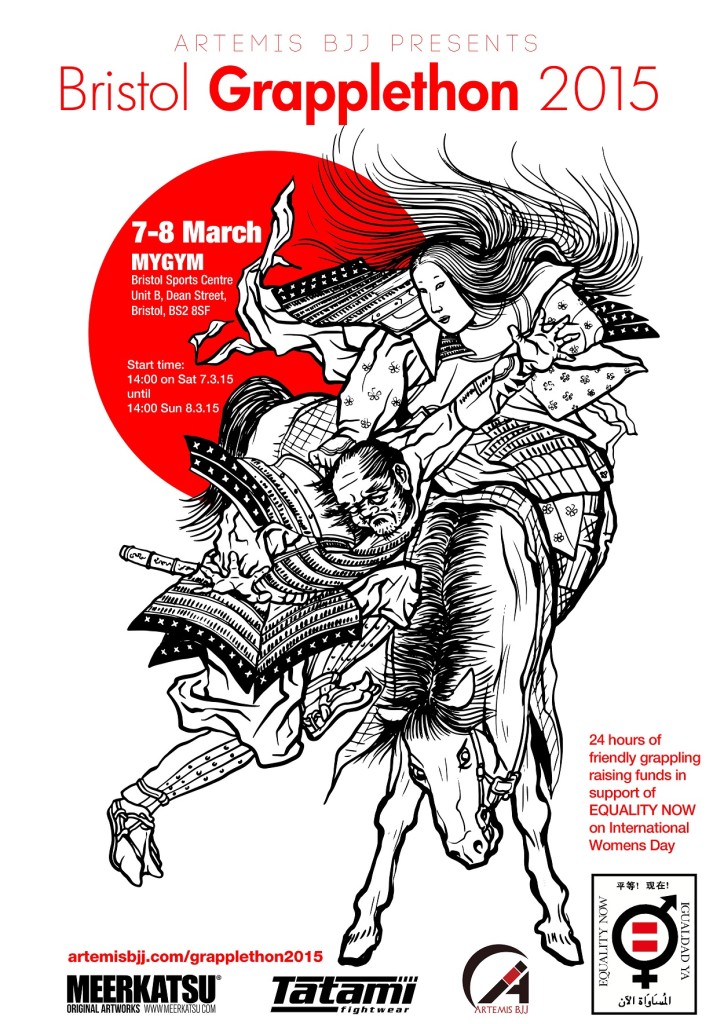Artemis BJJ (Easton Road), Can Sönmez, Bristol, UK - 16/09/2019
Short Version:
- Bump to knock their weight forwards
- Secure their arm to your chest
- Push their trapped-arm side knee back with your elbow
- Step your same-side foot over that leg, slide it towards your other bum cheek
- Bridge up and into them to roll, then immediately posture up
Full Version: For the trap and roll escape (commonly called the 'upa', which presumably means something in Portuguese), a typical starting point would be when they try to establish their first grip on your collar (or your neck, if you aren't wearing a gi) for a choke. That provides you with a chance to trap their arm. The usual grip would be to grab their wrist with your opposite hand, then just above their elbow with your other hand. This is the preferred grip on Gracie Combatives. The reasoning is that this grip prevents your opponent from drawing back their arm for a punch.
There are various other possibilities, such as the option I first learned, which was gripping their wrist with your same side hand, then grabbing the crook of their elbow with your opposite hand. That has the advantage of helping you wedge your elbow and arm into their chest, which provides additional leverage when rolling them over. Having said that, you can still use your elbow with the Gracie Combatives grip, it's just slightly less effective as your arm starts further away from their torso.
Whatever grip you choose, you then need to trap their leg on that same side. Otherwise, they will be able to use their leg for base as you attempt to roll them. In order to prevent that, step your same side foot over their lower leg, hooking it in tightly to your bum. This means they are now like a chair with two of its legs missing. If you aren't too flexible and therefore can't easily bring your leg back, push it back with your other leg. For some extra control, slide your controlling foot horizontally across towards your bum, which should eat up some more space. If you aren't flexible, you could try pushing it in place with your other foot (a tip I learned from my student Jim the first time I taught this to him, as he's had part of his hamstring removed).
Even if they can't post with their leg, they might be able to use their knee, so you want to have their leg as tightly locked to your body as possible. Also, be careful that you don't end up hooking both their feet, or leave your other leg in range of their hook. It is possible for the person on top to defend this escape by securing a hook with their free leg, under your non-trapping leg. Therefore, try to keep the leg they might be able to control out of range.
A common problem is that you're having trouble trapping their foot, because it is too high up. If that happens, try using your elbow (or even your hand, if you need more reach, but that could leave your neck vulnerable) to shove their knee backwards, until their lower leg is in range. This is an advantage of the Gracie Combatives grip, as putting a hand behind their triceps puts your elbow in a good position for shoving back their knee.
Yet another option, if their arm is not in range, is to bridge enough to bump them forward, nudging them in the bum with your knee if you want more leverage. That should mean they are forced to post out their hands for balance, a difficult instinct to ignore. That puts their arm within reach. You can then wrap both of your arms around one of theirs, gable gripping your hands (palm to palm). Suck that arm into your chest, clamping it at the elbow.
To finish, you're going to bridge towards that trapped side. As with basic side control escapes, get your heels close to your bum first for maximum leverage. Bridge up and over your shoulder, turning to your knees: this puts you inside their guard. Make sure that you're bridging over your shoulder and not simply rolling over to your side. If you don't raise your hips properly, you may merely give up your back.
If you find you need more leverage, most commonly if they are posting with their free hand to stop your roll, you could attempt to dislodge that by pushing their arm off the ground. Alternatively, Rickson Gracie has a great detail, which he demonstrated in a video a while ago. Simply angle your head away from the shoulder you're rolling over: this increases your range of motion.
When you've successfully rolled them over, that puts you in the guard position. Remember to posture up immediately as you reach that position: if you are leaning forwards, they can control your posture, putting you at risk of a submission.
________________
Teaching Notes: Forgot to do the bridging drills, that's important. Getting that angled bridge, could also emphasise it during the side control escape drills, noting how it's got broader applicability? Also, nice details by Matt Thornton: angling trapping leg out, shoulder towards hip.

